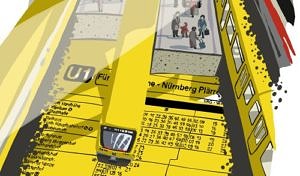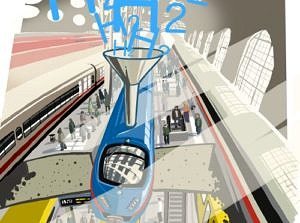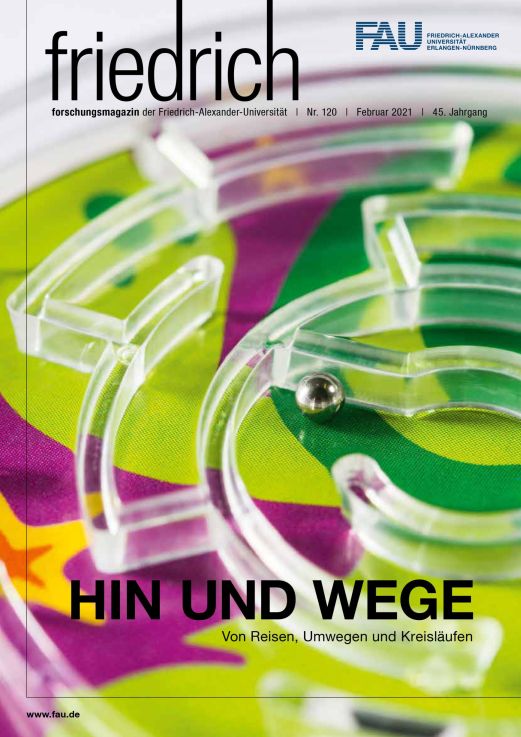Full steam ahead
On average, a typical train on the Nuremberg underground network weighs 140 tonnes. A considerable amount of energy is needed to get this heavyweight moving. Up to 7,500 kilowatts of electricity can be drawn off the grid by the engines of all trains travelling at one time. Such peaks in demand are expensive and account for up to 25 percent of total energy costs. Whilst they cannot be avoided entirely, they can at least be reduced, as when a train brakes, it returns electricity to the grid. However, this recuperation, which is also used in electric cars, dissipates if the energy is not required by another train at just the right time.
Mathematicians optimising underground train operations
The ideal situation would be for as few trains as possible to be pulling away at the same time, and for one train to accelerate whenever another brakes. Scientists at the Chair of Applied Mathematics (mixed whole-number linear and non-linear optimisation) led by Prof. Dr. Alexander Martin have been pursuing this ideal scenario for four years now in the project ‘Advanced driver assistance systems in rail transport’. By collaborating with VAG Verkehrs-Aktiengesellschaft Nürnberg, which operates the underground network in Nuremberg, and the Fraunhofer Institute for Integrated Circuits (IIS), the researchers hope to find out how to avoid high peak loads by adjusting train timetables. One prerequisite is that departure times are not allowed to be shifted by more than 15 seconds, to avoid unnecessary disruption to passengers.
It should be clear even to a lay person that a calculator is not going to get you far under these conditions. ‘The underground network in Nuremberg has three lines and 50 stations,’ says Dr. Andreas Bärmann, who is in charge of the project at FAU. ‘A total of 24,000 departure times have to be set every single day. Combined with 21 possible deviations for each one and the various speed profiles of the trains, that results in approximately 1031733 possible timetables.’ It is impossible for even the most experienced planner to manually assess all possible options and choose the one with the greatest potential for saving energy. The aim of the project is therefore to develop efficient algorithms for solving the task commissioned by VAG.

Bärmann can rely on a strong team: the three doctoral candidates Patrick Gemander, Lukas Hager and Oskar Schneider have already explored the topic of energy-efficient rail transport in their Master’s theses. They are receiving valuable support from their mentor Alexander Martin, who is not only a skilled expert in the optimisation of complex systems, but also has decades of experience in working with industry. The software designed by the mathematicians to help timetable planners make their decisions works on the principle of whole number optimisation. The number of all theoretically possible timetables is initially displayed as a scatter diagram. The advantage of this is that the position of the dots in the abstract space directly show which timetables would be more energy-efficient than others. Cleverly restricting the solution set over and over again on the basis of its geometric properties allows the number of timetables under consideration to shrink until finally only what has been mathematically proven to be the best solution remains.
Before they were able to start their calculations, the researchers first had to gain specialist knowledge of how rail operations actually work. What is the traction of the engines, and how much electricity do they require? How much time do passengers need to safely board and disembark? How long do trains take to turn after reaching their terminal station? How is the safety distance between trains measured? All of these parameters were entered in the system in order to ensure the validity of the results. The groundwork paid off: under ideal circumstances, up to 40 percent of electricity taken out of the power supply can be fed back into the grid and used again.
Coasting does not cost a lot of time but saves a lot of energy
Rescheduling timetables is only one approach to save energy. Another area where potentially considerable savings can be made involves the speed profiles of the trains. The mathematicians calculated the benefits of not letting trains accelerate to their full final speed and of coasting more often. ‘Everyone who drives a car knows what we’re talking about,’ says Patrick Gemander. ‘You take your foot off the accelerator and let your car coast when approaching a traffic light or entering a town. It saves fuel, and you lose virtually no time.’ The effect is much more pronounced with trains, as there is very little friction between the wheels and the tracks, and a considerably larger mass is being moved. The simulation showed some surprising results: If the underground train only accelerates to 75 instead of 80 kph and then coasts into the next station, it only needs on average three seconds more for a distance of 1000 metres, but uses up to one third less energy.
Passengers are unlikely to notice a 15 second delay in their departure times, or an increase of three seconds between stops. However, the benefits are eye-opening. The Nuremberg underground would use up to 10 percent less energy, allowing VAG to save over a million euros per year. As the next step, the FAU team hopes to collaborate with Frauenhofer IIS to develop intelligent algorithms which can control the trains in real time and react to any disruptions. The Nuremberg underground was the perfect candidate for the pilot project, as it already uses computer-operated, driverless trains. The promising project was awarded the innovation prize ‘Intelligent Solutions for Transport and Logistics’ from the Center for Transportation and Logistics Neuer Adler e.V. (CNA).
Locomotives powered by hydrogen instead of diesel

Feeding braking energy back into the grid is not always an option, however, as almost half of the railway network in Germany is not electrified. It is unrealistic to expect every track to be covered by an overhead line in the foreseeable future. Converting to electricity across the board would simply be too expensive and involve too much effort. Researchers are looking into alternatives to diesel engines to allow trains to become independent from fossil-based energy sources in future. Hydrogen is one particularly promising option, and ideally CO2 neutral hydrogen gained from renewable sources.
In terms of its weight, hydrogen carries almost three times as much energy as petrol and it can either be burned directly or converted into electricity in fuel cells. However, handling hydrogen is not easy. ‘Hydrogen is highly explosive and for storage and transportation it has either to be cooled to temperatures below -253°C or stored as a gas at very high pressures of up to 700 bar,’ explains Dr. Patrick Preuster, project co-ordinator at the Helmholtz Institute Erlangen-Nürnberg for Renewable Energy (HI ERN). ‘Supplying hydrogen across the board under these conditions would require complex and very costly new infrastructure.’
Carrier oil as liquid ‘refillable bottle’
LOHC technology may provide the solution. The procedure has been developed by the Chair of Chemical Reaction Engineering at FAU, led by Prof. Dr. Peter Wasserscheid, and uses dibenzyltoluene, a heat transfer oil belonging to the group of aromatic hydrocarbons, as an organic carrier liquid. Hydrogen is initially split by catalysis into individual atoms, then attaches to the double bonds in the carbon when being prepared for transport. A single litre of LOHC (Liquid Organic Hydrogen Carrier) can bind more than 650 litres of hydrogen and release it as and when required. The procedure can be repeated several thousand times before the carrier oil has to be renewed.
LOHC is not only suitable for transporting large quantities of hydrogen, it is also extremely easy to handle as it is not classed as a hazardous substance. Its physical properties mean that it can be transported just like traditional fuels, in other words in tanker trucks, trains or pipelines, and delivered to filling stations at train stations for dehydration, using a catalyst to release the hydrogen carried in the LOHC. The hydrogen could then be used to fill the tank of trains such as the Coradia iLint from the company Alstom, which was the first fuel-cell driven passenger train to be entered into service in 2018.
LOHC directly on the train
Even though these are still pilot projects, the scientists are already thinking one step ahead. ‘Our aim is to refuel LOHC directly on the train,’ says Patrick Preuster. ‘The hydrogen would then be released whilst driving and converted to electricity in a fuel cell.’ Researchers at HI-ERN are working to adjust the apparatus for releasing hydrogen by catalysis for mobile use. The aim is not only to make the technology smaller and lighter, but also to optimise it for dynamic load changes. This should ensure that enough hydrogen is always available, even in instances when a lot of power is required such as moving off and going up inclines.
By 2022, these adjustments should be far enough on to allow the technology to be tested in a demonstration project. ‘We will fit out a local train with two fuel cells, each of which produces 200 kilowatts,’ says Preuster. ‘That is roughly equivalent to the power of four Toyota Mirais.’ Currently, the greatest hurdle is the high temperature of 250 to 300 degrees Celsius which is required for the dehydration of LOHC. Preuster explains, ‘in order to reach such high temperatures, we have to burn some of the hydrogen. That makes it harder for us to reduce the size of the technology to a minimum for it be used in mobile scenarios, and it also has a negative effect on our energy balance.’
The team led by Patrick Preuster is working on two strategies to solve the problem. The first approach involves developing dehydration units which can work at considerably lower temperatures. The second approach is even more revolutionary: a fuel cell which produces electrical energy directly from the laden LOHC. There would then be no need for any additional equipment for releasing the hydrogen by catalysis on board the train. According to Preuster, ‘hydrogen closes the gap between renewably generated electricity and providing power for heavy vehicles. ‘And LOHC is the ideal carrier to safely transport hydrogen using the infrastructure we have today.’
About the author
Matthias Münch studied sociology before working as a freelance journalist for several daily newspapers. Since 2001, he has been providing support for companies and academic institutions in the areas of PR and corporate communication.
FAU research magazine friedrich
 This article first appeared in our research magazine friedrich. You can order the print issue (only available in German) free of charge at presse@fau.de.
This article first appeared in our research magazine friedrich. You can order the print issue (only available in German) free of charge at presse@fau.de.
